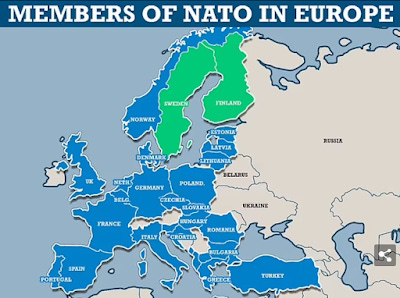From a historical and military planning point of view, it is hard to understate the sea change this represents not just for NATO but for the nations’ involved.
Finland will launch an immediate debate on joining NATO, Finnish officials said on Wednesday, as the country reconsiders its longtime stance outside the Western military alliance following Russia’s invasion of Ukraine.
Prime Minister Sanna Marin said that a decision would be made in coming weeks.
“There are different perspectives to apply (for) NATO membership or not to apply and we have to analyze these very carefully,” she said at a news conference in Stockholm, according to Reuters. “But I think our process will be quite fast.”
Marin spoke alongside Swedish Prime Minister Magdalena Andersson, who said Sweden was also re-examining its position outside NATO, after Russian President Vladimir Putin’s Ukraine offensive plunged Europe into its most serious security crisis since World War II.
Serving at in many NATO HQ’s in a separate “Partnership for Peace” wing of a building or such, the military from Finland and Sweden have had personnel assigned to NATO for years. We served together in Afghanistan and elsewhere for a long time. It would be hard to be more turnkey NATO member states than Finland and Sweden, but the political and societal inertia in both nations kept their neutrality in place.
Even before the Russo-Ukrainian War, there was a drift – especially in Finland – towards NATO membership, but old habits and memories are difficult to overcome unless there is a big push.
Finland has only been an independent nation for a little more than a century, and her neutrality was part of her negotiated survival after WWII. Sweden has maintained a strict neutrality from her squabbling European neighbors since the end of the Napoleonic Wars.
This is not a small move for NATO or the nations involved. You can add this to your list of reasons we are living through one of those pivot points in history. Big pivot or small – well – we need to wait for more cards to come out of the deck to answer that question.
Clearly, this brings more security to Finland and Sweden to keep the bear at bay, but what doesn’t bring to NATO?
It consolidates NATO’s northern flank. In the event of conflict, it will simply make things move quicker and faster for NATO to make it more difficult for the Russians to move west of Bear Island at sea, and Karelia on land.
That being said, Finland only has a population of 5.5 million with a per capita income of $51,650. They are just a tad under spending 2% GDP on defense, but will probably be just over it this year.
Sweden has a population of 10.3 million with a per capita income of $56,270. In 2020 she spends 1.3% of GDP on defense, up from 2019’s 0.9%. She is expected to reach 2% by 2028, but with the events of this year, I bet on that moving up.
So as a benchmark, The Netherlands has a population of 17.4 million and a per capita income of $59,700 and spends 1.4% of GDP on defense and rising.
So, in essence NATO gets ~another Netherlands. More important that that is – as always – geography.
NATO’s northern flank is now more secure – even though we now have a much longer border with Russia. Finland and Sweden will be less subject to bullying. Central and Western Europe – with the exception of those quirky mountain folk in the center, some fussy Balkan bits etc – is more united with most of North America against Russia.
Remember, win or lose, at the end of this Russia will still be Russia. The Steppes will still be The Steppes.
You should all know that history. A militarily united Europe, spot-welded to Anglospheric North America, is a recipe for security and peace for all.
If not that, a recipe for a better chance to defeat an enemy on the march.
Take the “W.”



